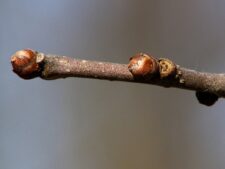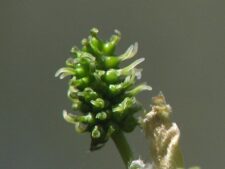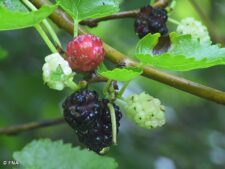
This medium-sized tree has a trunk which is often stained dark brown by oozing sap (B). The winter twigs have brown, spherical buds (C). The leaves are highly variable in size, shape and texture (A,H). In October the leaves turn a distinctive greenish-yellow as seen on the ground under a tree (I). They are rough or shiny, often lobed, but the lower surfaces are always smooth (D). Male and female flowers are found on separate trees (E-male, F-female). The fruit is a white, pink or nearly black berry (G). In comparison, the Red Mulberry (Morus rubra) has fuzzy hairs on lower leaf surfaces, and much less variable, mostly larger, heart-shaped leaves.
Found on floodplains, especially near streams, flowering in April and May. It is also commonly found growing in fencerows as seed is dispersed by perching birds. In Fontenelle Forest, common in the Wetlands. At Neale Woods, common on MRE Trail.
This tree was introduced from China in the 1600’s in an effort to establish a silk industry as it is the preferred food source of silk worms. That venture soon failed, but the White Mulberry tree is now well established throughout Nebraska and the rest of the Midwest.
White Mulberry has also been known to hybridize with the native Red Mulberry (Morus rubra).
The content of NatureSearch is provided by dedicated volunteer Naturalists of Fontenelle Forest who strive to provide the most accurate information available. Contributors of the images retain their copyrights. The point of contact for this page is: Roland Barth.








